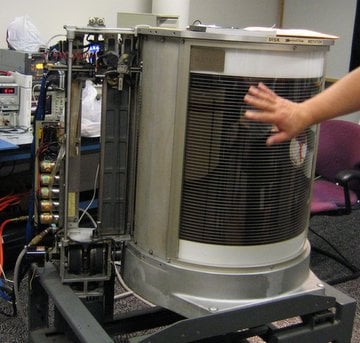*Image Credit: Wikimedia Commons The early computer industry, built around room-sized machines filled with vacuum tubes, made a giant leap forward when IBM announced it would soon be manufacturing the 305 RAMAC — Random Access Method of Accounting and Control — as a commercial machine with a secondary storage system called a disk drive. Built to manage the financial needs of large, fast-moving operations, the hulking machine would form the bridge between IBM’s traditional computing methods and more advanced electric-only designs that would follow. Capable of storing 3.75MB of information, the adjoining IBM 350 disk storage unit consisted of fifty metallic disks using an electromagnetic charge to transfer information. Within months, the first RAMAC had found its way into the auto industry, helping Chrysler Automotive keep track of parts manufactured in the company’s MOPAR plants and the orders generated by salesmen on the road. Up until that point, workers had used a tub file — a series of punched cards stored according to the frequency of use — in order to enter information. With an ability to access information in just 600 milliseconds, the RAMAC was a vast improvement. Over the course of a five-year production run, well over a thousand units were produced, finding their way into as different locations as the underground offices of secure military facilities and the home offices of the 1960 Winter Olympics in Squaw Valley. In any case, the RAMAC could fit into a relatively small (by standards of the day) 30-foot by 15-foot room and fit through a standard doorway. Consisting of a central computer, disk drive, operator console and a printer, organizations leased the machines from IBM for $3,200 per month (equivalent to nearly $23,000 in 2006). The five foot tall by five-and-a-half foot wide storage system is what really set the RAMAC apart from anything before it. Able to hold onto commands and reproduce information faster than punch card systems in place at the time, the machine could manage the wide scope of calculations necessary to keep the variety of numbers involved in a large enterprise straight. When engineers first proposed the idea, however, IBM executives baulked at the idea — it would cut into the company’s success as a supplier of punch card-based equipment. Unwilling to let the idea, laboratory workers continued refining the idea at the San Jose, California testing facility until IBM’s President agreed to allow the project to move into production. According to historians, the patent used on the disk drive (US 3,503,060) is the first of its kind in history — making the 350 storage unit the great-grandfather of the highly technological society in existence today. Within three years, IBM debuted the next step in computing technology, the 1400 series computer. Production for the RAMAC ended soon after, with the entire system pulled from service during 1969 in favor of newer machines running on transistors.
September 13, 1956 CE – IBM Introduces the 305 RAMAC, a Computer with the First Disk Drive System
*Image Credit: Wikimedia Commons The early computer industry, built around room-sized machines filled with vacuum tubes, made a giant leap forward when IBM announced it would soon be manufacturing the…
557
